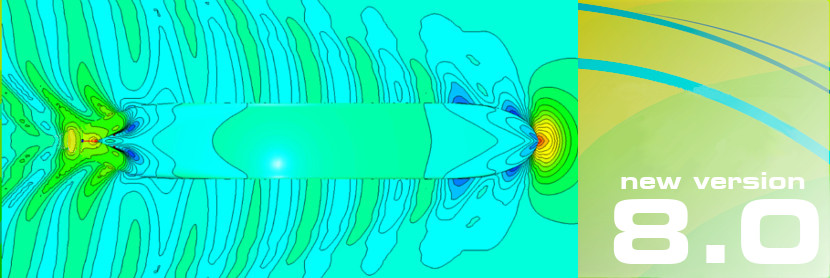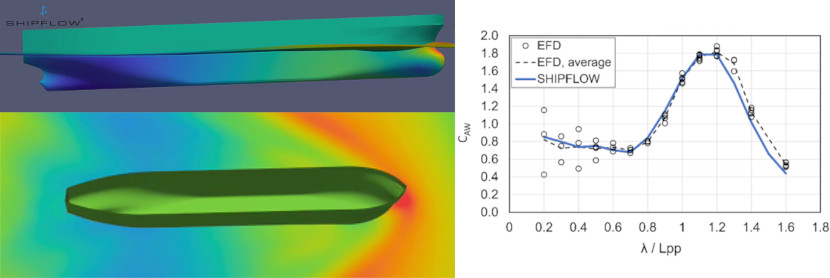Friendship Systems -- Software Partner
Flowtech has a long term collaboration with Friendship Systems. Friendship Systems concentrate their efforts on developing CAESES a CAE/CAD tool for design and optimization. There is an excellent and seamless integration between CAESES and SHIPFLOW. They also provide us with the slimmed version SHIPFLOW Design, which is a subset of CAESES.
Both companies act as resellers of each others software.
Chalmers Technical University -- Research Partner
The SHIPFLOW software is a commercialisation of research CFD code from Chalmers Technical University. This research is continuously ongoing and will keep providing new major implementations in SHIPFLOW.
SSPA -- Collaboration Partner
Flowtech and SSPA collaborate on various research and development projects, internally or government funded. We also work together with outside customers on development projects encompassing CFD and model testing.
On-Demand Cloud service
SHIPFLOW users can now perform simulations on the Rescale cloud high performance computing (HPC) platform.
Web: www.rescale.com
Email: info@rescale.com
Tel: +1-855-737-2253
Resellers:
ASEAN:
Caidmark Sdn Bhd
Email: csb@caidmark.com.my
Tel: +603 - 7729 9390 Fax: +603 - 7727 9804
China:
Nanjing Tianfu Software Co.,Ltd
Information: info@njtf.cn
Tel.:+86-25-57928188
India:
Shiretechnik Solutions Pvt. Ltd.
Address: No. 166, 5th Main K.E.B layout, Sanjaynagar, Bangalore, Karnataka, India, Pin – 560 094
Contact: Debasis Panda
Tel: +91-9620031209
E-mail: dpanda@shiretechnik.com
Web: www.shiretechnik.com
Japan:
Sumitomo Heavy Industries Marine&Engineering Co., Ltd.:
Contact: Tel: + 81 3 6737 2620, Fax: + 81 3 6866 5169
FLOWTECH International AB
Chalmers Tvärgata 10
P.O. Box 24001
SE-40022 Göteborg
Sweden
VAT no: SE556377585601
Phone +46 (0)31 41 05 06
www.flowtech.se
FLOWTECH International AB
SHIPFLOW stems from long term research at FLOWTECH International AB in close cooperation with SSPA and the Naval Architecture Department at Chalmers University of Technology.
The number of SHIPFLOW licenses has grown steadily since the first version was released by FLOWTECH in 1992. Top Shipyards, Consultants and Universities are among the SHIPFLOW users. Developed by naval architects, physicists and numerical analysts the software is optimised for ship hydrodynamics design. Specialisation means SHIPFLOW is effective and user friendly. No general purpose code can compete with SHIPFLOW in hull design: grids are automatically generated, resistance and propulsion data are presented in the naval architects way and the solvers are adapted for hull geometries. Over the past twenty years SHIPFLOW has developed into the world standard for ship hydrodynamics CFD.
Combination of CFD Tools -- a Key Feature
Lead times are more and more compressed in ship design, particularly at the initial phase where many variants need to be evaluated in a short period of time. An efficient possibility is offered by the potential flow panel methods in the SHIPFLOW. The module XPAN, which predicts important quantities like waves and wave resistance rapidly, yet with accuracy sufficient for hull ranking, and SHIPFLOW MOTIONS which predicts the ship motions and added resistance in waves. Viscous effects are also important and implemented in the SHIPFLOW module XCHAP. Using SHIPFLOWS advanced gridding technique an array of optimisations can be done. For example, bare hull total resistance, flow into the propeller plane, propeller open water tests, self propulsion, appendage optimisation etc.
Advanced gridding technique
Creating grids is paramount and the key to SHIPFLOW's success. This is where the SHIPFLOW specialisation towards Naval Architects is most obvious. Firstly, grids for the RANS solvers as well as meshes for XPAN are created automatically from the hull shape. Various types of hull shapes can be handled, such as monohulls, twin skeg hulls, multihulls, sailing yachts etc. In addition to this SHIPFLOW uses an efficient overlapping grid technique for use with appendages. This method has the advantage of being very flexible making optimisation of appendages convenient. Using parameters and coordinates the design, position and orientation of the appendage can be varied. An example of appendage is energy saving devices which are then easily varied and optimized. Other examples are, rudders, brackets, shafts, vortex generators, pod struts and housings etc. All interactions between the grids are taken care of automatically.
Complete Package
SHIPFLOW Design – Advanced/Basic is a complete package including pre processing, gridding/meshing, CFD-solvers and post processing. We are able to offer this due to our close cooperation with Friendship Systems. Friendship Systems make and market an advanced optimisation tool -- CAESES. SHIPFLOW Design is a subset of this program with some limitations when it comes to optimisation and parametric modelling.
Naturally we are happy to package SHIPFLOW together with CAESES.











